Tomatoes are a favorite vegetable for many gardeners, prized for their rich flavor and widespread adaptability. Their juicy, flavorful fruits add freshness and nutrition to countless meals. However, many gardeners encounter a frustrating problem when their tomatoes start rotting on the bottom, often just as the fruits are ripening. This not only diminishes the quality and yield but also raises concerns about plant health and possible diseases.
If you’ve found your tomatoes developing dark, sunken spots on the bottom, you’re not alone. This common issue has a specific cause and, thankfully, practical solutions exist. Understanding why tomatoes rot at the bottom and how to fix it is essential for any gardener hoping to enjoy a healthy, productive tomato harvest.
Table of Contents
What Causes Tomatoes to Rot on the Bottom?
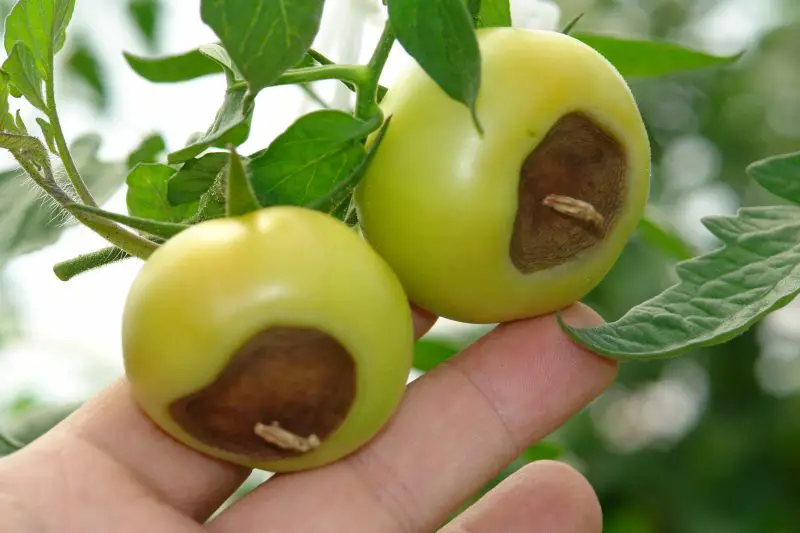
The rot that appears on the bottom of tomatoes is typically caused by a physiological disorder known as blossom end rot (BER). Unlike fungal or bacterial infections, blossom end rot is not a contagious disease but rather a problem arising from calcium deficiency in the fruit’s developing tissue.
Calcium is a vital nutrient that helps maintain the structural integrity of plant cell walls. When tomato plants cannot supply enough calcium to their fruits, the cells at the blossom end start to collapse and decay. This leads to the characteristic dark, leathery patches at the bottom of the tomato.
Several factors can cause calcium deficiency in tomatoes, even if the soil has sufficient calcium. Irregular watering is one of the main culprits. When soil moisture fluctuates dramatically between dry and wet, tomato roots struggle to absorb calcium efficiently. Rapid growth of the plant, especially fueled by high nitrogen fertilizers, can also increase the demand for calcium beyond what the plant can supply.
Environmental stresses such as hot weather, drought, or overly wet soils further complicate calcium uptake. The roots may become damaged or stressed, reducing their ability to transport nutrients. Additionally, some soil types or pH imbalances can limit calcium availability.
The Role of Calcium and Nutrient Uptake in Tomatoes
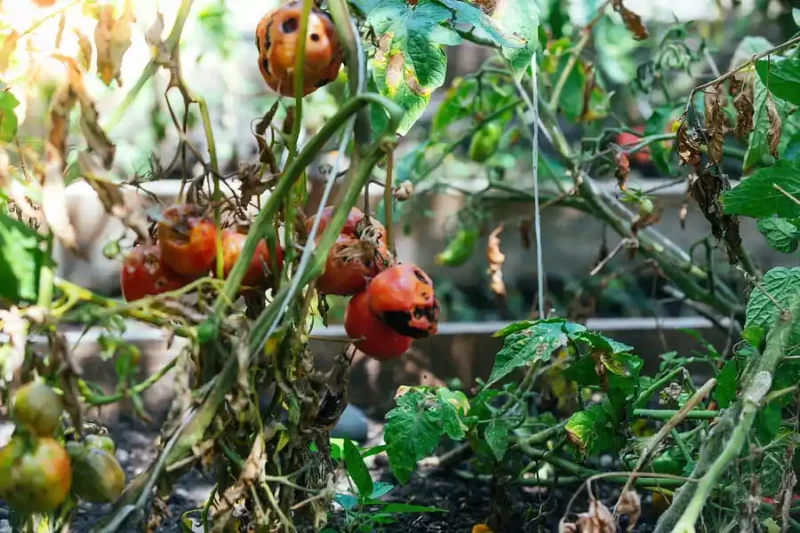
Calcium moves from the soil through the tomato plant’s roots and vascular system by the movement of water. Therefore, calcium uptake is heavily dependent on consistent water supply. Without regular moisture, calcium cannot travel efficiently to the developing fruits.
Unlike some nutrients stored in leaves or roots, calcium is not easily redistributed within the plant. This means that once the fruit starts growing, it relies entirely on a steady calcium supply through the roots. If water stress or root damage occurs, the calcium supply to the fruit can be interrupted, resulting in blossom end rot.
Other nutrients, such as potassium and magnesium, also influence tomato health. However, an imbalance in nitrogen fertilizer is a frequent problem. Too much nitrogen encourages excessive leafy growth but can reduce calcium transport to the fruit, worsening the problem.
How Watering Affects Tomatoes Rotting on the Bottom
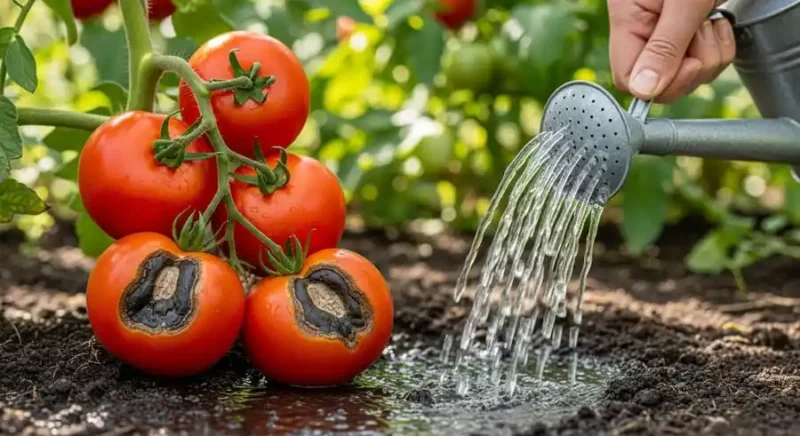
Maintaining consistent soil moisture is one of the most effective ways to prevent and fix tomatoes rotting on the bottom. Tomatoes prefer evenly moist soil that is neither too dry nor waterlogged.
When soil dries out completely between waterings, the plant undergoes stress, closing its stomata to reduce water loss. This limits transpiration, the process that moves water and nutrients—including calcium—from roots to leaves and fruits. As a result, calcium delivery to the developing tomato fruit is reduced, causing blossom end rot.
Conversely, overwatering can damage the roots and reduce their ability to absorb calcium. Poor drainage leads to oxygen-starved roots, which cannot function properly. Hence, watering should be deep and regular but balanced to avoid extremes.
Using irrigation methods that deliver water slowly and directly to the root zone, such as drip irrigation or soaker hoses, helps maintain optimal moisture levels and reduces water waste. Mulching around tomato plants further conserves moisture and keeps soil temperature stable, benefiting root health.
Soil Quality and Its Impact on Bottom Rot in Tomatoes

The quality and composition of soil directly affect the availability of calcium and other nutrients. Tomatoes grow best in well-draining, fertile soil rich in organic matter. Compacted or sandy soils may hinder root growth and nutrient uptake.
Testing soil before planting provides valuable information on nutrient levels, including calcium content and pH balance. Calcium becomes less available in highly acidic or alkaline soils. Ideally, tomato soil should have a slightly acidic to neutral pH, around 6.0 to 7.0, to optimize nutrient availability.
Amending soil with lime or gypsum can increase calcium levels, but these should be applied based on soil test recommendations to avoid over-application. Organic matter such as compost improves soil structure and water retention, supporting healthy roots and better nutrient absorption.
Fertilizer use also plays a role. Excessive nitrogen application encourages rapid leaf growth at the expense of fruit development and calcium transport. Balanced fertilizers formulated for tomatoes or vegetable gardens help maintain steady growth and fruit quality.
Environmental Stressors That Lead to Tomato Bottom Rot
Beyond watering and soil nutrients, environmental conditions influence the risk of tomatoes rotting on the bottom. High temperatures, especially sustained heatwaves, can stress plants and reduce calcium uptake.
Extreme weather patterns, including drought periods followed by heavy rain, cause fluctuating soil moisture that disrupts nutrient transport. Windy conditions increase transpiration rates, leading to quicker water loss and potential moisture stress if watering is insufficient.
Using mulch can help regulate soil temperature and moisture, protecting the roots from environmental fluctuations. Providing shade during extreme heat or selecting heat-tolerant tomato varieties may also reduce stress and the incidence of blossom end rot.
How to Fix Tomatoes Rotting on the Bottom
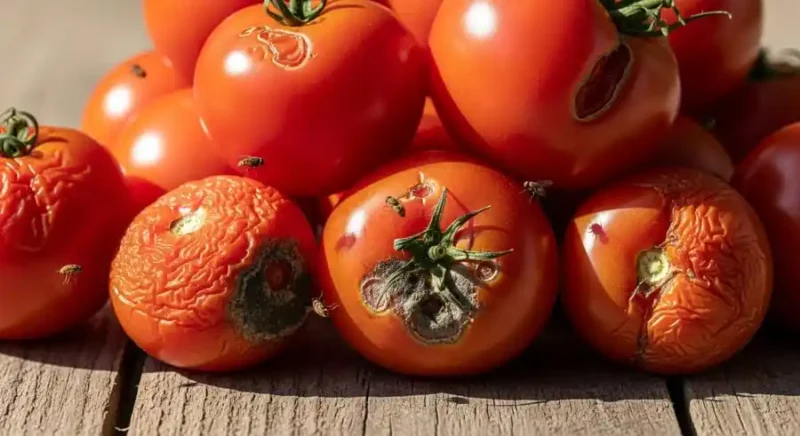
Fixing tomatoes rotting on the bottom involves addressing the underlying causes, primarily calcium deficiency and inconsistent watering.
Begin by establishing a consistent watering routine. Water tomatoes deeply and regularly to maintain even soil moisture. Avoid letting the soil dry out completely or become saturated. Using drip irrigation or soaker hoses is ideal for delivering water directly to roots.
Applying mulch around plants conserves soil moisture, reduces temperature fluctuations, and prevents soil splashing onto fruits, which can introduce pathogens.
If soil tests show calcium deficiency, amend the soil carefully with lime or gypsum as recommended. In the short term, foliar sprays of calcium can help deliver nutrients directly to fruit and leaves, providing temporary relief.
Reduce nitrogen fertilizer usage if excessive. Opt for balanced fertilizers to encourage steady growth and nutrient uptake.
Choosing tomato varieties known for resistance to blossom end rot can also be effective, especially in regions prone to environmental stress.
Preventing Future Bottom Rot Problems in Tomatoes
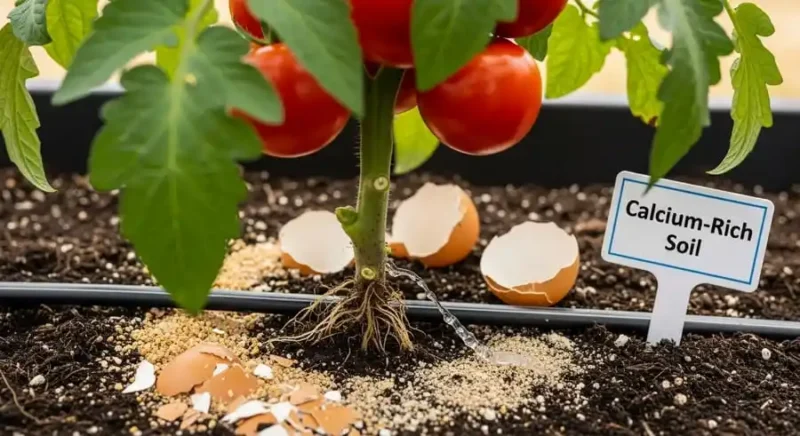
Prevention is always better than cure. Preparing soil well before planting by adding organic matter and ensuring proper pH helps create a strong foundation.
Maintain consistent watering schedules adapted to weather conditions. Using soil moisture meters or simply checking soil with fingers can guide irrigation timing.
Practice crop rotation and avoid planting tomatoes in the same spot every year to reduce soil depletion and disease risk.
Stake or cage tomato plants to keep fruits off the soil, reducing rot risks from moisture and pathogens.
Regularly remove damaged or rotten fruit and keep the garden clean to promote healthy growth.
Common Misconceptions About Tomato Bottom Rot
One common misconception is that bottom rot is caused by a fungal or bacterial infection, leading gardeners to apply unnecessary fungicides or pesticides. Blossom end rot, however, is a physiological issue caused by calcium deficiency, not an infectious disease.
Another mistake is over-fertilizing with nitrogen to “feed” the plants, which often worsens the problem by promoting leafy growth over fruit health.
Some believe watering less will prevent rot, but inconsistent or insufficient watering is a primary cause of the disorder. Maintaining steady moisture is key.
When and How to Harvest Tomatoes to Avoid Bottom Rot
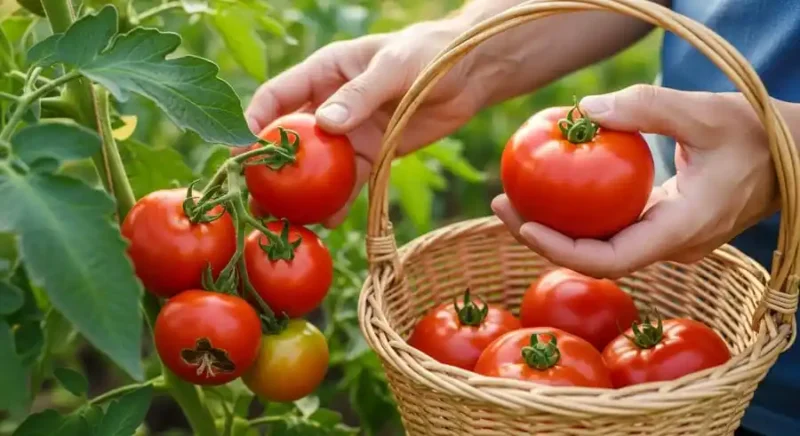
Timely harvesting also reduces losses from bottom rot. Overripe tomatoes left on the vine too long are more prone to rot and secondary infections.
Harvest tomatoes once they reach mature color and firmness. If rot appears early on some fruits, remove those promptly to prevent spread.
Keeping an eye on developing fruits throughout the season allows for early detection and intervention.
FAQ – Why Are My Tomatoes Rotting on the Bottom?
What is the main cause of tomatoes rotting on the bottom?
The primary cause is blossom end rot, a physiological disorder caused by calcium deficiency in the developing fruit, often linked to inconsistent watering and environmental stress.
Can I save tomatoes affected by bottom rot?
While affected tomatoes cannot fully recover, improving watering practices, soil calcium levels, and overall plant care can prevent further damage and protect new fruits.
Does blossom end rot spread from one tomato to another?
No, blossom end rot is not contagious. It results from nutrient imbalance rather than an infection, so it doesn’t spread between fruits.
How often should I water tomatoes to prevent bottom rot?
Tomatoes need consistent, deep watering to keep soil evenly moist. Avoid letting the soil dry out completely or become waterlogged; daily watering during hot weather is often necessary.
Can foliar calcium sprays fix bottom rot?
Foliar calcium sprays can provide a temporary boost but should be used alongside proper soil and watering management for lasting results.
Final Thoughts
Tomatoes rotting on the bottom is a widespread challenge but one that gardeners can manage effectively with knowledge and care. Recognizing that blossom end rot results from calcium deficiency caused by irregular watering, poor soil conditions, and environmental stress helps focus efforts on practical solutions.
By maintaining consistent watering, improving soil health, balancing fertilization, and selecting resistant varieties, gardeners can greatly reduce the incidence of bottom rot. With patience and attention, it’s possible to enjoy a plentiful harvest of healthy, delicious tomatoes season after season.






